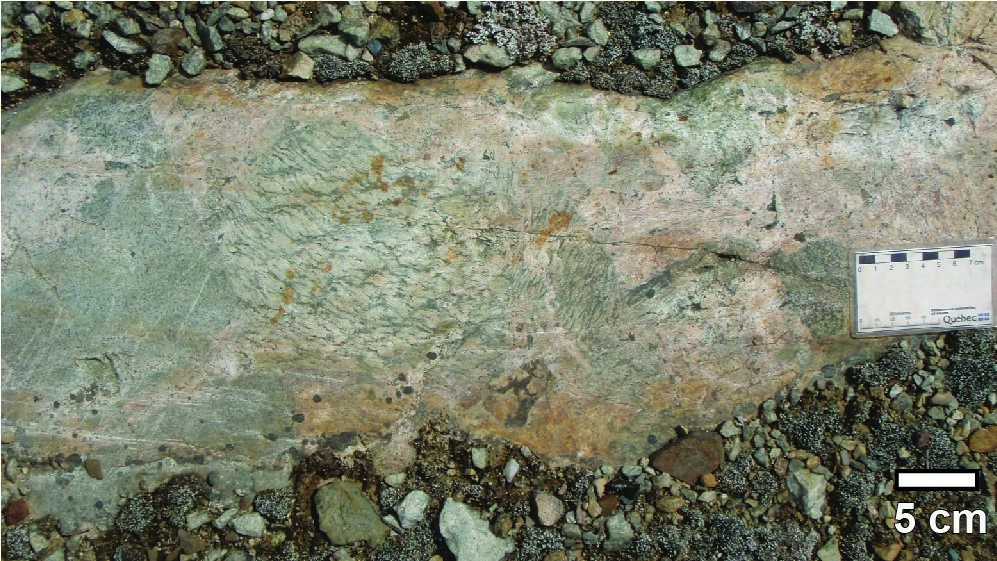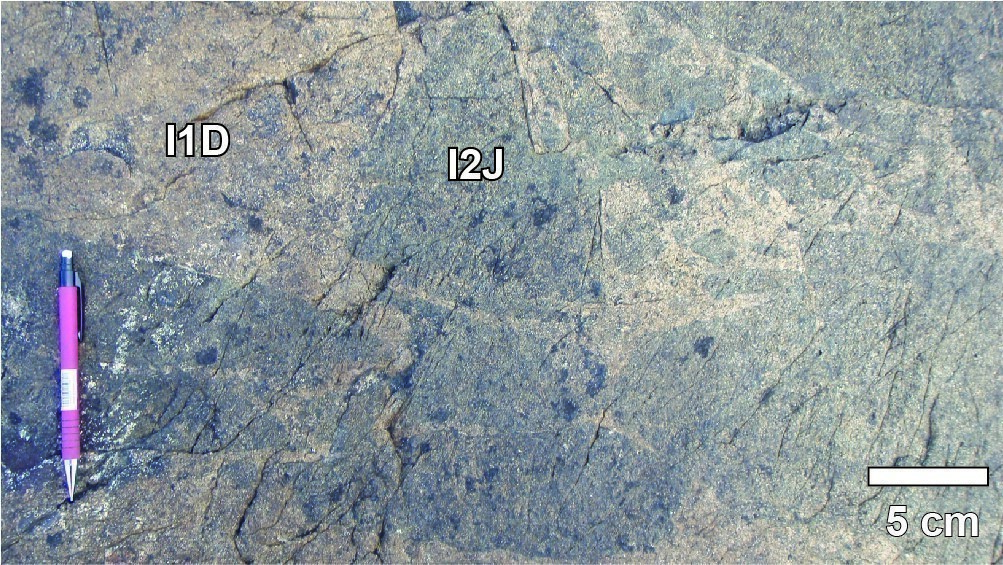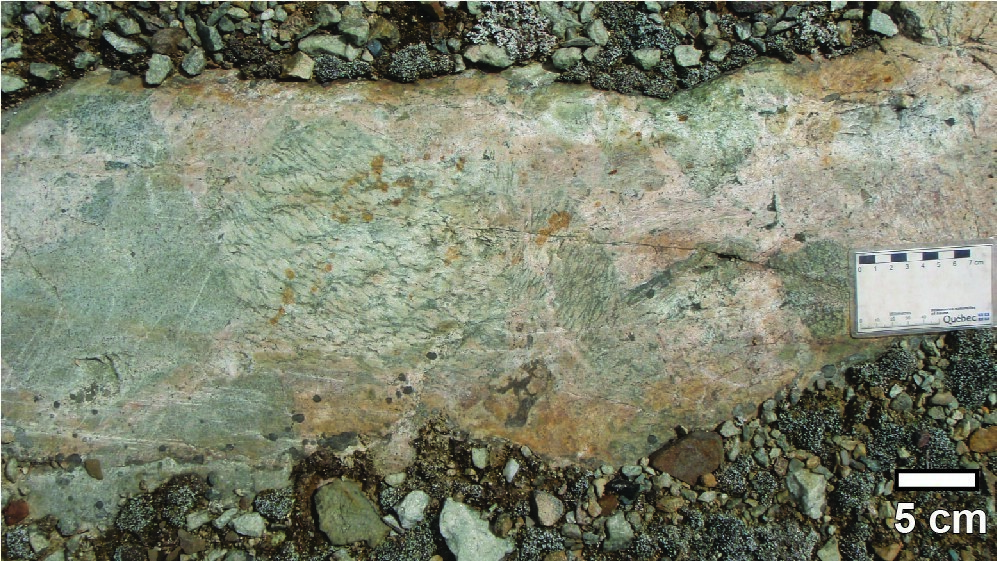
nAchi6 Quartz diorite dyke, porphyritic tonalite (grey dyke)
nAchi5 Gabbro and diorite dyke (mafic and intermediate dyke)
nAchi4 Intrusion breccia consisting of tonalite with diorite, basalt and quartz gabbro enclaves
nAchi3 Trondhjemite and porphyritic trondhjemite (leucotonalite)
nAchi2 Tonalite with lesser amounts of hornblende diorite and quartz diorite, tonalite and porphyritic diorite dykes
nAchi1 Hornblende diorite and quartz diorite with lesser amounts of biotite-hornblende tonalite and trondhjemite, tonalite and porphyritic diorite dykes
| Author: | Allard, 1956 |
| Age: | Neoarchean |
| Reference section: | None |
| Type area: | None |
| Geological province: | Superior Province |
| Geological subdivision: | Abitibi Subprovince |
| Lithology: | Diorite, tonalite, trondhjemite |
| Type: | Lithodemic |
| Rank: | Lithodeme |
| Status: | Formal |
| Use: | Active |
- Chibougamau Pluton
- Chibougamau Pluton breccia zone
Background
The Chibougamau Pluton was originally designated as the “Lac Chibougamau Mass” by Mawdsley and Norman (1935) and included in the Lac David Group by Graham (1956). It was named “Lac Chibougamau Pluton” by Allard (1956) and more simply “Chibougamau Pluton” in subsequent publications (Allard, 1976; Racicot, 1980, 1981).
Description
Chibougamau Pluton 1 (nAchi1): Hornblende Diorite and Quartz Diorite with Lesser Amounts of Biotite-Hornblende Tonalite and Trondhjemite, Tonalite and Porphyritic Diorite Dykes
According to Leclerc et al. (2017, page 28): “Heterogeneous diorite is the oldest unit. It consists of a hornblende facies (subunit nAchi1a) and a non-mappable quartz facies that are typically cut by minor intrusions, dykes and veinlets of biotite-hornblende tonalite or porphyritic trondhjemite. Heterogeneous diorite is mainly observed at the pluton’s periphery and south of Chibougamau Lake and also includes a brecciated facies that will be described below […]. North of the lake, it was observed in the Merrill Mine area.”
Chibougamau Pluton 2 (nAchi2): Tonalite with Lesser Amounts of Hornblende Diorite and Quartz Diorite, Tonalite and Porphyritic Diorite Dykes
According to Leclerc et al. (2017, page 28): “The central part of the Chibougamau Pluton is dominated by an even-grained to porphyritic biotite tonalite unit. This heterogeneous unit contains subangular to rounded, generally decimetric to metric, enclaves of hornblende diorite and quartz diorite. […] This unit hosts the Queylus Breccia.”
Chibougamau Pluton 3 (nAchi3): Trondhjemite and Porphyritic Trondhjemite (Leucotonalite)
According to Leclerc et al. (2017, page 28): “The biotite trondhjemite and porphyritic trondhjemite unit, also known as leucotonalite, outcrops south of the Merrill Mine in the Devlin and Corner Bay deposits’ area (SW of NTS sheet 32G16), and in the Lamothe area (east of sheet 32G16). It is characterized by a small amount of mafic minerals (<5%), an abundance of quartz and a porphyroclastic texture.”
Chibougamau Pluton 4 (nAchi4): Intrusion Breccia Consisting of Tonalite with Diorite, Basalt and Quartz Gabbro Enclaves
According to Leclerc and Houle (2013, page 9): “The southwestern edge of the Chibougamau Pluton is characterized by an intrusion breccia zone marking contact between volcanic rocks of the Andy Member (Waconichi Formation) and unit nAchi1. This breccia has a matrix of foliated heterogeneous tonalite. It contains fine-grained diorite enclaves, highly rounded, fractured and cut by veinlets of tonalite, aphyric basalt and quartz gabbro with plagioclase crystals (<5 mm).”
Chibougamau Pluton 5 (nAchi5): Gabbro and Diorite Dyke (Mafic and Intermediate Dyke)
Gabbro and diorite dykes (nAchi5) correspond to diorite and meladiorite dykes of Maillet (1978). They are particularly abundant in the NW portion of Caché Lake, where they cut intrusive rocks of the Lac Doré Intrusive Suite (Houle, 1990; Leclerc et al., 2017).
Chibougamau Pluton 6 (nAchi6): Quartz Diorite Dyke, Porphyritic Tonalite (Grey Dyke)
Quartz diorite dykes (unit nAchi6) correspond to the very fine-grained grey dykes of Maillet (1978) “generally consisting of the chilled margin of porphyritic dykes and tonalite dykes” (Houle, 1990; Leclerc et al., 2017).
Chibougamau Pluton 7 (nAchi7): Sericitized Tonalite Dyke (Acidic Dyke)
“Acidic dykes” include porphyritic felsic dykes (quartz ± plagioclase ± hornblende phenocrystals) and tonalite and porphyric tonalite dykes. They are generally associated with NW-SE shear zones; they are completely sericitized and contain disseminated pyrite (Houle, 1990; Leclerc et al., 2017).
Thickness and Distribution
The Chibougamau Pluton covers an area of 450 km2 and follows the Chibougamau Anticline’s axial trace, whose E-W orientation shifts to NE-SW as it approaches the Grenville Front Tectonic Zone (Daigneault and Allard, 1990, 1994).
Dating
Samples of hornblende meladiorite (nAchi1) returned a crystallization ages of 2718 ±2 Ma (Krogh, 1982) and 2716 +3/-2 Ma (Pilote et al., 1997; Joanisse, 1998). A sample of porphyritic quartz tonalite dyke from Clark Lake (nAchi7) yielded a crystallization age of 2715 ±1 Ma (Pilote et al., 1996). At the Merrill Mine pit, a sample of diorite dyke (nAchi5) cut by mineralization and a sample of porphyritic tonalite dyke (nAchi7) cutting mineralization (nAchi7) yielded an identical crystallization age of 2714 +3/-2 Ma (Pilote et al., 1997; Joanisse, 1998). A sample from the tonalitic stock at the Merrill Mine pit also yielded an age of 2714 +3/-2 Ma (Pilote et al., 1997; Joanisse, 1998). At Copper Rand, a sample of quartz diorite dyke (nAchi6) yielded a crystallization age of 2705.1 +1.7/-1.2 Ma (David et al., 2011; reanalysis by Joanisse et al., 1998). A sample of porphyritic leucotonalite in the Queylus Bay area was dated 2701.7 ±2.9 Ma (unpublished data, McNicoll et al., 2008).
| Isotopic System | Mineral | Crystallization Age (Ma) | (+) | (-) | Reference(s) |
| U-Pb | Zircon | 2718 | 2 | 2 | Krogh, 1982 |
| U-Pb | Zircon | 2716 | 3 | 2 | Pilote et al., 1997; Joanisse, 1998 |
| U-Pb | Zircon | 2715 | 1 | 1 | Pilote et al., 1996 |
| U-Pb | Zircon | 2714 | 3 | 2 | Pilote et al., 1997; Joanisse, 1998 |
| U-Pb | Zircon | 2705.1 | 1.7 | 1.2 | David et al., 2011 |
| U-Pb | Zircon | 2701.7 | 2.9 | 2.9 | McNicoll et al., 2008 |
Stratigraphic Relationship(s)
The Chibougamau Pluton cuts volcano-sedimentary rocks at the base of the Roy Group (Obatogamau and Waconichi formations), as well as mafic to ultramafic rocks of the Lac Doré Intrusive Suite. The contact of the pluton’s southern part is characterized by a discordance above which lie sedimentary rocks of the Opemisca Group (Stella and Haüy formations). The eastern part of the Chibougamau Pluton is cut, on the one hand, by granodiorite intruding into the Mistassini Fault (oriented NNE-SSW) and, on the other, locally by biotite tonalites characterizing the Parautochton.
Paleontology
Does not apply.





